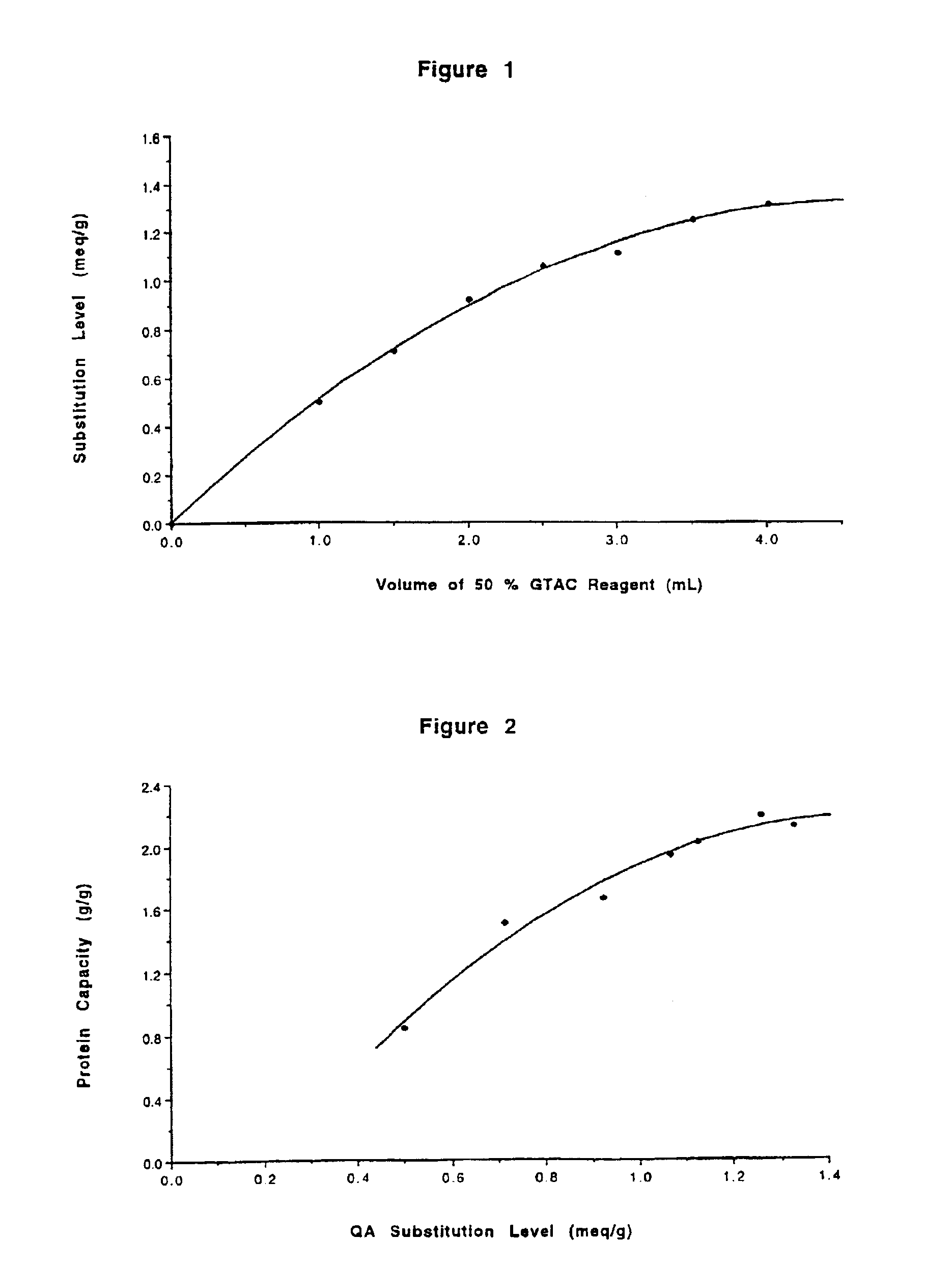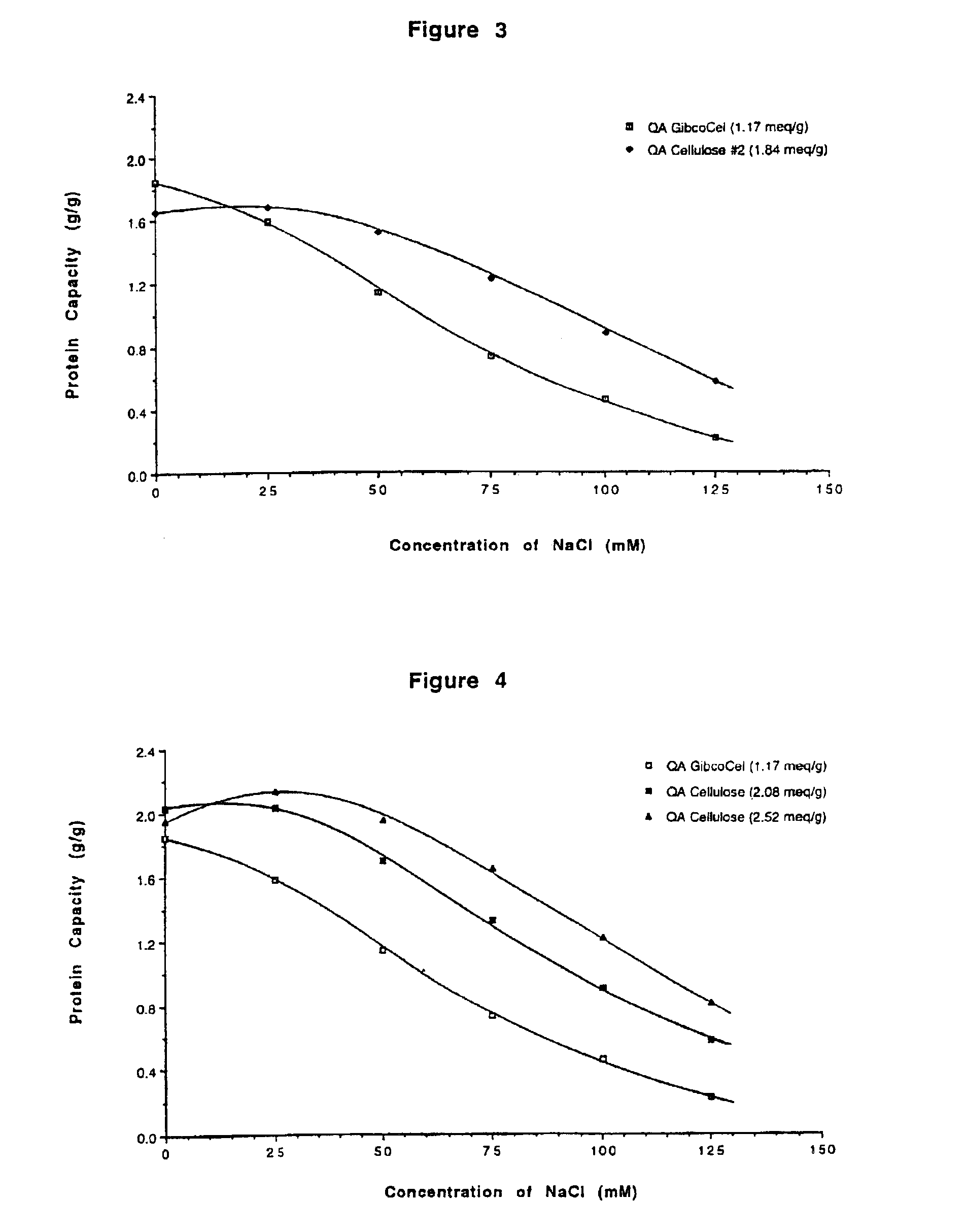Ion exchangers
a technology of anion exchanger and ion exchanger, which is applied in the field of new, can solve the problems of not being able to make and demonstrate products on the very large scale needed for use, and unable to meet the requirements of large-scale industrial us
- Summary
- Abstract
- Description
- Claims
- Application Information
AI Technical Summary
Benefits of technology
Problems solved by technology
Method used
Image
Examples
example 2
[0061]QA GibcoCel™ HG2 (1.17 meq / g), a commercially available anion exchanger made from the same granular regenerated cellulose as used in Example 1, was obtained from Life Technologies Ltd, Auckland, New Zealand. It was suspended in water and then collected on a sintered-glass filter where it was washed with 1 M hydrochloric acid, water, 1 M sodium hydroxide and finally de-ionised water. It was then drained of excess water by vacuum filtration. This QA cellulose in its hydroxide form was then further alkylated to raise the density of positively charged QA groups.
[0062]The QA GibcoCel™[OH−] was made up to a thick slurry by the addition of water and 30% (w / v) aqueous sodium hydroxide. The mixture was chilled before adding (3-chloro-2-hydroxypropyl)trimethylammonium chloride (60 wt. % solution in water). The amounts used are shown in Table 1. These ingredients were mixed as a slurry for 17 hours at room temperature followed by 2 hours at 60° C. The QA cellulose products were collected...
example 3
[0065]The β-lactoglobulin capacity tests on the four QA celluloses described in Example 2 were repeated in the presence of 80 mM sodium chloride. This was achieved using the capacity test as described in Example 1 except that the β-lactoglobulin was dissolved in 0.01 M sodium dihydrogen phosphate containing 80 mM sodium chloride and adjusted to pH 7.5. The results are shown in Table 2. When the ionic strength of the test solution was deliberately raised in this way then an increase in the protein capacity of 50% or more was observed when the substitution level of QA GibcoCel™ was raised to >1.5 meq / g.
[0066]
TABLE 2β-Lactoglobulin Capacities of QA Cellulosesin 80 mM NaC1 at pH 7.5PreparationQA GibcoCel#1#2#3S.I.C. (meq / g)1.171.511.842.02β-1g capacity (g / g)0.640.981.101.11
example 4
[0067]The effect of ionic strength on β-lactoglobulin binding capacities of QA GibcoCel™ (1.17 meq / g) and the QA cellulose preparation #2 (1.84 meq / g) from Example 2 was further investigated using a capacity test similar to that outlined in Example 1 but with sodium chloride present at different concentrations. This was achieved as follows.
[0068]A 1% solution of β-lactoglobulin was prepared in 0.02 M sodium dihydrogen phosphate. The pH of this solution was carefully adjusted to 7.5 with 5 M sodium hydroxide. Samples of ion exchanger (300-400 mg) were weighed into glass vials. To these were added enough water and 1 M sodium chloride, together totalling 10 mL, to give final sodium chloride concentrations of 0, 25, 50, 75, 100 and 125 mM following the later addition of 10 mL of the protein solution. After mixing gently for 2 hours a sample of the supernatant was taken and assayed at 280 nm as described in Example 1. The results are shown in FIG. 3. In the presence of sodium chloride at...
PUM
| Property | Measurement | Unit |
|---|---|---|
| Equivalent per mass | aaaaa | aaaaa |
| Equivalent per mass | aaaaa | aaaaa |
| Equivalent per mass | aaaaa | aaaaa |
Abstract
Description
Claims
Application Information
 Login to View More
Login to View More - R&D
- Intellectual Property
- Life Sciences
- Materials
- Tech Scout
- Unparalleled Data Quality
- Higher Quality Content
- 60% Fewer Hallucinations
Browse by: Latest US Patents, China's latest patents, Technical Efficacy Thesaurus, Application Domain, Technology Topic, Popular Technical Reports.
© 2025 PatSnap. All rights reserved.Legal|Privacy policy|Modern Slavery Act Transparency Statement|Sitemap|About US| Contact US: help@patsnap.com



